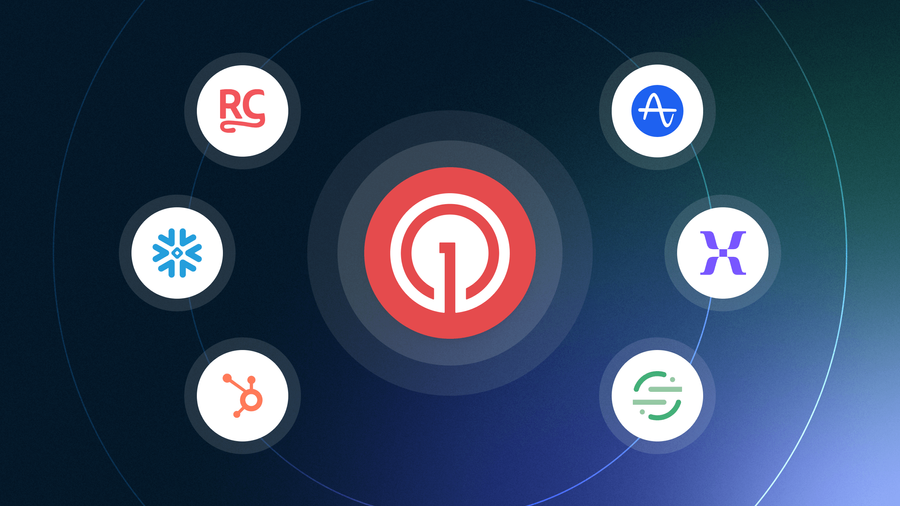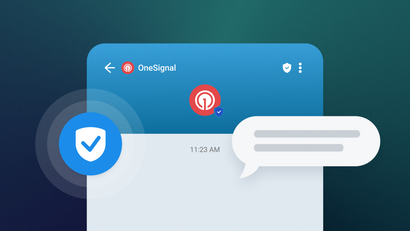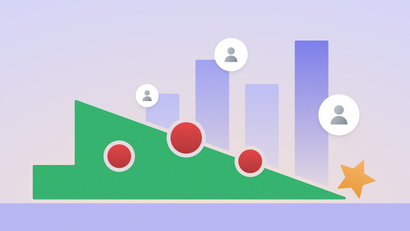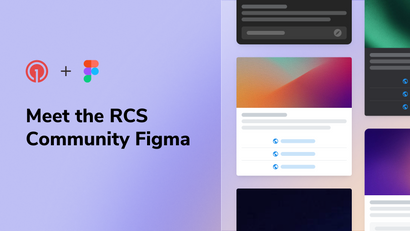For mobile-first business, there’s no one-size-fits-all playbook for customer engagement. If there was, every app would have a 100% retention rate and we’d all be out of a job.
What works for a gaming studio might flop for a fintech app. A fast-scaling delivery brand probably doesn’t need the same segmentation depth as a media company juggling churn. That’s the whole point of OneSignal: one platform built for all the different ways teams actually engage.
And that’s why we’re highlighting the OneSignal integrations that our customers find most impactful, and the ones that make it simple to sync with the platforms you already trust.
1. RevenueCat: Tie messaging directly to subscription revenue
If you’re already using RevenueCat to manage in-app purchases and subscriptions, you know how valuable that data is. With OneSignal, that same revenue data becomes the trigger for perfectly timed messages that drive upgrades, renewals, and re-subs.
What OneSignal + RevenueCat allows you to do:
Sync purchase events, cancellations, renewals, and trial status from RevenueCat into OneSignal. This gives you the ability to target campaigns with surgical precision: upsell to active subscribers, win back churned users, or nurture free trials toward conversion.
Contrary to popular belief, timing is almost everything. In reality, your campaigns should be directly tied to the moments that drive revenue. This integration closes that gap, turning subscription events into automated campaigns that grow LTV without adding extra work for your team.
Learn more about the OneSignal + RevenueCat integration
Use cases:
- Win back churned subscribers with a targeted offer delivered at the moment they lapse.
- Nudge free trial users toward conversion when they hit key usage milestones.
- Celebrate renewals with personalized “thank you” messages that reinforce loyalty.
How to install: Connect your RevenueCat project to OneSignal using the RevenueCat integration guide, then map relevant events into Journeys.
Best fit for: Subscription-driven apps (media, fitness, productivity), mobile game studios with IAP monetization, and product leads who need to tie engagement directly to revenue.
2. Snowflake: Make messaging data part of your single source of truth
Snowflake is the backbone of analytics for many mid-market and enterprise teams. With OneSignal, your engagement data plugs directly into that backbone; no sense in pretending like a duct-taped pipeline is good posture, right?
What OneSignal + Snowflake allows you to do:
Export all your OneSignal messaging events (delivered, opened, clicked, converted) directly into Snowflake. This makes it easy to combine messaging performance with product analytics, user attributes, and revenue data in one place.
With engagement signals sitting alongside product and revenue data, you get a complete picture of what’s working, what isn’t, and where to double down.
Learn more about the OneSignal + Snowflake integration
Use cases:
- Track messaging performance side-by-side with retention cohorts.
- Measure the revenue lift from campaigns and prove ROI to leadership.
- Enrich churn models with push open/click behavior.
How to install: Use the Snowflake integration guide to securely connect your OneSignal project to your Snowflake instance.
Best fit for: Data-driven teams that live in their warehouse, product and growth analysts looking to join engagement data with product usage, and marketing leaders who need crystal clear ROI attribution.
3. HubSpot: Extend your CRM into mobile channels
HubSpot might run your customer workflows, but with OneSignal, those same workflows extend beyond email into push, in-app, and SMS—meeting customers where they actually spend most of their time.
What OneSignal + HubSpot allows you to do:
Sync HubSpot contacts and lifecycle events into OneSignal, then use those triggers to orchestrate push, in-app, SMS, and email campaigns. That means every HubSpot workflow now has the power to lift activation, boost retention, and drive revenue across mobile.
Learn more about the OneSignal + HubSpot integration
Use cases:
- Push notifications for new trial sign-ups that align with HubSpot lifecycle stages.
- In-app onboarding nudges triggered when HubSpot workflows update.
- Coordinated omnichannel campaigns where HubSpot emails and OneSignal pushes work in tandem.
How to install: Connect using the HubSpot integration guide and set up bidirectional sync.
Best fit for: Marketing managers already running HubSpot campaigns, growth teams who want to align CRM workflows with mobile-first engagement, and brands that rely heavily on nurturing free-to-paid conversions.
4. Amplitude: Turn behavior insights into real-time action
There’s a good chance you’re already using Amplitude to see what users are doing. With OneSignal, those insights don’t just sit in dashboards, they are put to work triggering real-time campaigns that keep users moving forward instead of dropping off.
What OneSignal + Amplitude allows you to do:
Forward Amplitude events (feature usage, drop-offs, milestones) into OneSignal and trigger contextual messaging the moment behavior happens. You can also loop data back to Amplitude to measure how those campaigns impact retention and feature adoption.
Learn more about the OneSignal + Amplitude integration
Use cases:
- Send a push notification when a user gets stuck or drops off after a key step.
- Trigger in-app tips when someone tries a feature for the first time.
- Run retention experiments and analyze results directly in Amplitude.
How to install: Set up event forwarding through the Amplitude integration guide.
Best fit for: Product managers, lifecycle marketers, and teams focused on driving feature adoption and reducing churn.
5. Mixpanel: Build cohorts that drive precision messaging
Mixpanel’s cohorts are already powerful for understanding users. With OneSignal, those cohorts become engagement audiences you can act on immediately.
What OneSignal + Mixpanel allows you to do:
Export Mixpanel cohorts into OneSignal and run highly targeted campaigns against them. Because cohorts are dynamic, your audiences update automatically—meaning your campaigns always stay relevant.
Learn more about the OneSignal + Mixpanel integration
Use cases:
- Send special offers to high-value users identified in Mixpanel.
- Trigger re-engagement pushes for users who haven’t logged in within 7 days.
- A/B test different retention messages against Mixpanel cohorts.
How to install: Use the Mixpanel integration guide to export cohorts directly into your OneSignal audience list.
Best fit for: Apps with varied user behaviors (gaming, media, fintech), growth marketers running heavy experimentation, and data teams who want precision targeting without extra manual work.
6. Twilio Segment: Centralize data, streamline messaging
If Segment is your team’s data hub, OneSignal fits right in as a ready-made destination—no new tracking setup required.
What OneSignal + Twilio Segment allows you to do:
Use Segment to forward clean, real-time user events and traits into OneSignal. This ensures your messaging always runs on the freshest data, and it keeps your tracking implementation lean. You can enrich OneSignal profiles with the same attributes already powering the rest of your stack.
Learn more about the OneSignal + Twilio Segment integration
Use cases:
- Trigger OneSignal campaigns based on events tracked in Segment.
- Maintain consistent user attributes across all tools without duplicate work.
- Use Segment data as the backbone for Journeys in OneSignal.
How to install: Add OneSignal as a destination in Segment, following integration steps here.
Best fit for: Engineering-light teams that want to avoid redundant tracking, growth marketers who rely on Segment as their customer data platform, and product leads who need consistency across their stack.
⭐️ Honorable Mentions
BigQuery: Bring messaging into your Google Cloud Analytics
If your team already runs on Google Cloud, BigQuery is likely your data warehouse of choice. With OneSignal, your messaging data slots right in.
What it allows you to do: Export engagement data into BigQuery for large-scale analysis, dashboarding, and machine learning.
Use cases:
- Blend push and in-app performance data with broader user behavior datasets.
- Build real-time dashboards that track campaign influence on churn and revenue.
Best fit for: Teams already invested in Google Cloud, analysts running ML models, and growth leads who want a direct line between messaging and performance metrics.
Databricks: Fuel AI-driven engagement strategies
Databricks is where many teams build advanced ML models and unified data pipelines. By feeding OneSignal data into it, your engagement signals become part of that innovation cycle.
What it allows you to do: Merge messaging data with broader data lakes, power AI models, and scale predictive engagement strategies.
Use cases:
- Train churn prediction models that incorporate push open/click behavior.
- Identify high-value cohorts for personalized offers at scale.
Best fit for: Data-heavy organizations, AI/ML teams, and product leaders looking to take messaging personalization to the next level.
Four words we live by: Your stack, your strategy
Some brands live and die by subscription revenue, others by daily retention, and others by personalized lifecycle marketing. The real advantage is being able to design campaigns around your specific growth levers, not just whatever a vendor decided should be your growth strategy.
Curious how these integrations could work in your stack? Chat with our team and we’ll walk you through it.
Ready to put these integrations to work? Get started with OneSignal for free and see how easy it is to connect, customize, and grow in the direction that actually reflects how your customers behave.
Get Started for Free



